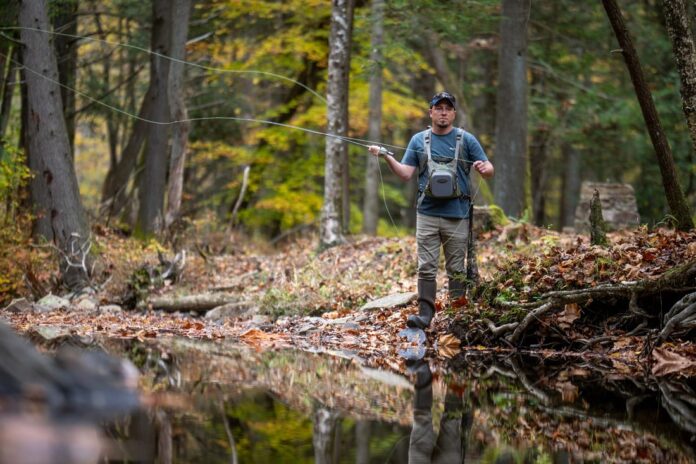I’ve heard it said many times that pitching is a game of adjustments.
That’s undoubtedly true. A hurler must adjust his rhythm, velocity, location, movement if he’s going to be successful at getting hitters out.
I once had a principal who said the key to being a successful teacher is keeping students off balance. Not allowing them to get too comfortable in the classroom. Keep them honest, he’d say.
And I think the same is true when it comes to fishing.
For instance, when old Sol crosses the threshold of summer, anglers must be willing to adjust their style and technique if they are to take advantage of some of the best fishing of the year.
The large, evening fly hatches are pretty much history by now.
If you want to catch trout this time of year, you might have to change more than thinking habits.
When the weather is hot and the streams begin to heat up, it’s time to alter your daytime schedule to include early mornings instead of late afternoons.
By the midafternoon, the streams usually have warmed up past the point that stimulates trout activity.
A few shady locations, of course, do hold their flows and remain cool all day, but these are the exception, not the rule.
Usually, when I get time in late summer to string up the fly pole, the best of the weather for fishing is all but departed.
After late August arrives, the prime period for angling is the cool hours of the morning, when the water temperatures are at their most comfortable ranges for trout.
Without getting into the technicalities of optimum temperatures for various trout and their cold-water kin, suffice it to say that water temps of about 62 degrees is perhaps the most desirable for taking brown, rainbow, and brook trout.
In his marvelous book, The Ways of Trout, the well-known fishing author Leonard Wright hypothesized that the closer and the quicker the water temperature approaches this optimum mark, the more active the trout become.
I’m in agreement with the trout expert’s hypothesis, and I think it explains why trout fishing seems better during the late June mornings.
For more information, and for technical advice, I urge you to consult those who fish for trout year-round. They know how to match the hatch; they know how to look at the stream to determine where the fish are lurking.
I’ve never mastered that level of angling.
I’m only an apprentice in comparison to those who have made a lifelong study of the sport, especially where trout are concerned. I’ve never been able to see trout the way seasoned fly fishermen do when they approach a stretch of waterway.
A log here, a rock there. The way the stream cuts into a bank. The way the ripples dance across the narrows. Even the murmuring eddies are coded messages for the sage angler who can discern the signs.
On streams that experience only a modest amount of fishing pressure, trout are usually not too far from cover.
Generally, most fish lying in currents unconcealed are caught and creeled early in the season.
To catch the warier, cover-seeking trout that remain, the fly-rodder must drift his flies along tree roots, around in-stream structure, to the base of riffled water, and along seams where a couple of different speeds of current meet.
In other words, fish the prime hangouts of feeding trout for best results.
So, gentlemen and ladies, during the month of June you might figure on floating your dry flies—the venerable Adams, the productive double-wings, the fluttering Caddis patterns—in sizes of 14 and 16 along the cool loops of meandering mountain streams.
If that doesn’t work, you can also opt for a pair of weighted nymphs, especially when the trout gather in the riffles during the hot weather to feed.
A friend of mine once whipped out a size 16 Muskrat Nymph with a copper bead head and went to work with furious abandon, hauling in a few very active trout which, apparently, were not shy about being taken on the simple, easy-to-tie pattern.
But enough.
Most outdoor writers like to stop after they’ve talked about dry fly fishing and nymph fishing in the month of June, before they get in over their heads, figuring they’ve told you everything you need to know to catch fish after the evening hatches have all petered out.
It’s the same with me.
And to be honest, I’ve caught more fish on a tiny black ant that I tied myself than the intricate fly patterns I bought at fly shops just to impress the natives.
Wet flies, for that matter, are probably just as effective if a fisherman really felt he could catch fish with them.
Whatever the occasion, though, change is still the key to summer fly-fishing success. You must be able to adjust your skills and temperament if you want to get the prize.
You must make certain adjustments, just like the guy on the mound with his fingers wrapped around the seams of the horsehide sphere.
So, whatever your pleasure, remember that the water temperature and the skill of the angler is more important than what’s on the end of your fly line.
Take advantage of the trout activity during the times favorable for fishing and you have a chance to put your lure into the mouth of a worthy adversary.
And like Yogi says, “Ninety-five percent of this game is half mental.”
—
Top o’ the morning!
Credit: Source link































